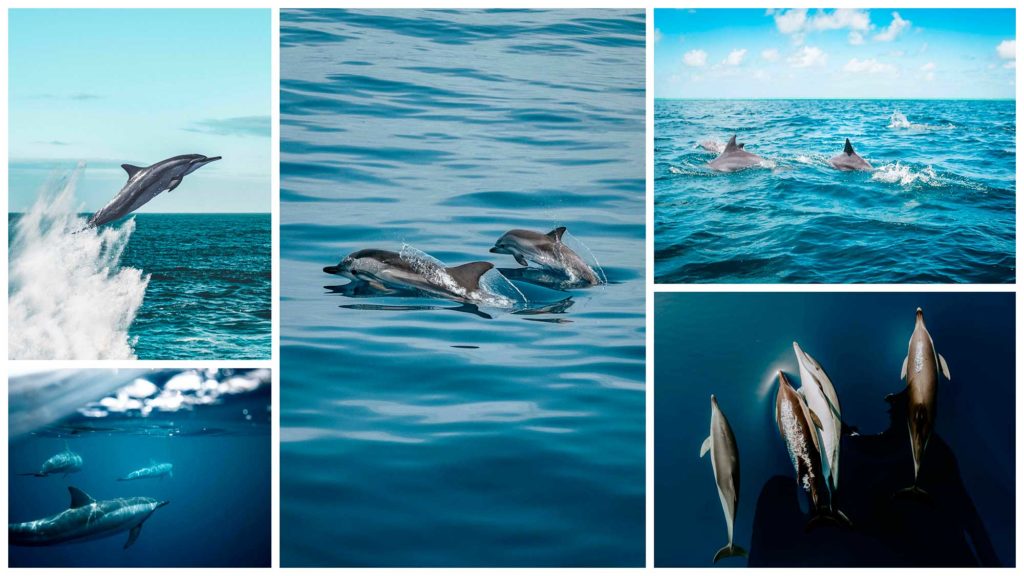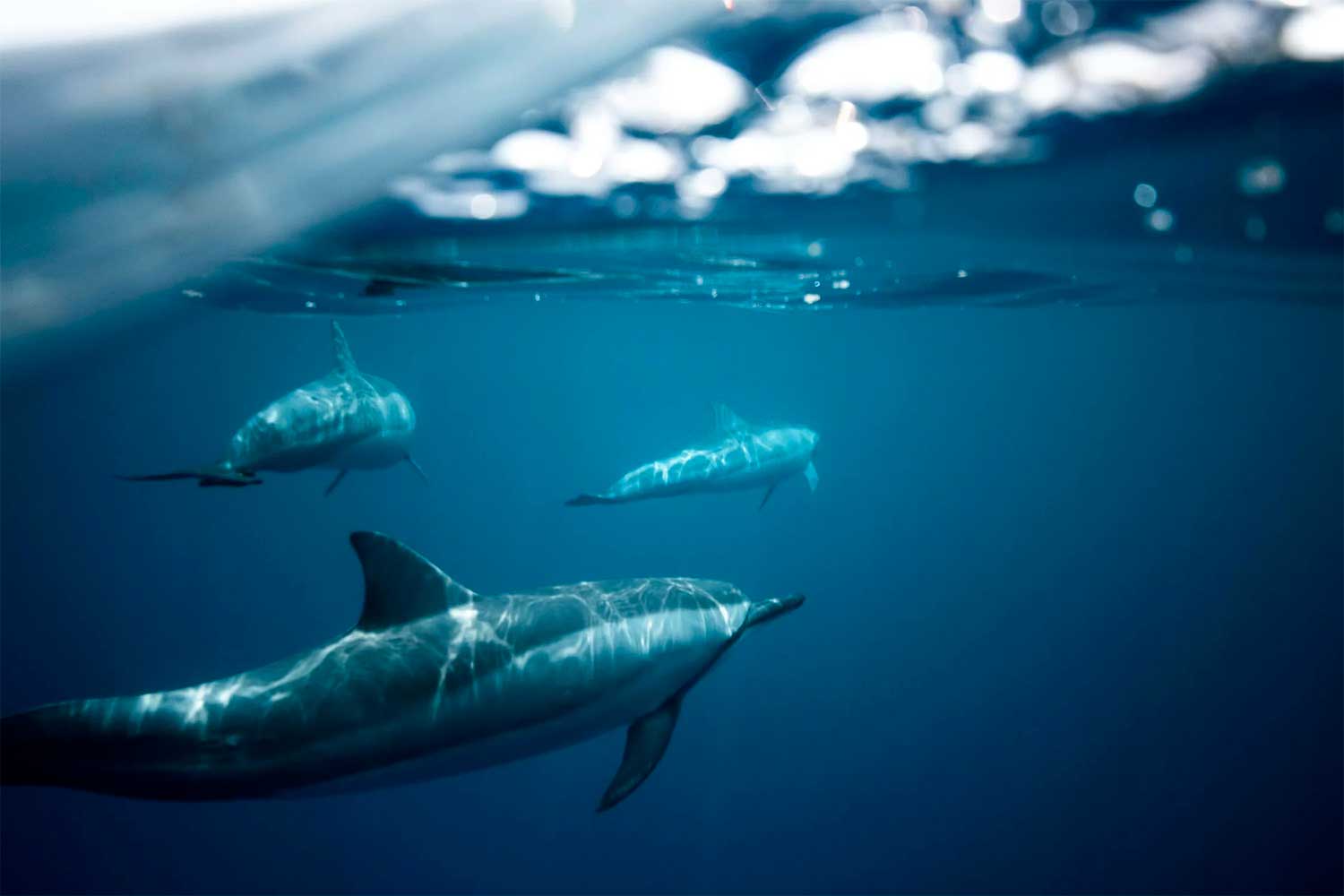Meet dolphins in their natural habitat: a magical experience to enjoy responsibly, far from the excesses of tourist captivity.
The fascination with dolphins: myth, attraction, and marketing
The image of the dolphin as a friendly and playful companion is deeply rooted in the collective imagination. Since the 1960s, with television series such as Flipper, cetaceans have been presented to the public as intelligent, benevolent creatures with almost human behavior. This perception has been reinforced by numerous documentaries, advertisements, and educational programs highlighting their ability to interact with humans, their apparent gentleness, and their natural “smile,” often misinterpreted as a sign of happiness.
This cultural construct has found massive resonance in the tourism industry. Swimming with dolphins has become one of the most sought-after activities in seaside destinations around the world, from Florida to Dubai, Mexico, Polynesia, Thailand, and the Maldives. According to the report The Case Against Marine Mammal Captivity (World Animal Protection / Whale and Dolphin Conservation), more than 3,000 dolphins are currently held in captivity in marine parks or tourist complexes around the world, generating an estimated turnover of more than €2 billion per year for the animal entertainment industry.
The success of this activity is based on a strong marketing promise: a unique, emotional, and sensory experience with an “intelligent and peaceful” animal. Tour operators exploit this fantasy by offering highly photogenic packages, often accompanied by pseudo-educational discourse that masks the animals’ real living conditions. The experience is designed for families, couples, and children, creating an “ideal” tourist product: accessible, spectacular, and emotionally engaging.
As a result, swimming with dolphins has become a symbol of modern beach tourism, combining exoticism, interaction with nature, and unforgettable memories. However, this massive popularity raises major ethical questions that only an analysis of the effects of these practices on the dolphins themselves can truly shed light on.
The effects of captivity and human interaction on dolphins
Dolphins, particularly bottlenose dolphins (Tursiops truncatus), are marine mammals with complex intelligence. In the wild, they live in structured social groups called “pods,” composed of several individuals united by lasting bonds. Their communication is based on a sophisticated system of sounds, whistles, clicks, and body gestures. These vocal signals are used for navigation, hunting, interaction, and even recognition of each other through “signature whistles,” which are comparable to proper names.
In captivity, these behaviors are profoundly altered. Artificial pools, even in the most modern facilities, cannot replicate the complexity of the marine environment or the distances traveled daily in the wild (up to 100 km per day). Several studies have highlighted the harmful effects of this deprivation on the well-being of dolphins. Behavioral disorders, known as stereotypies, frequently occur: repetitive movements, lethargy, self-mutilation, and aggressive behavior. Chronic stress is also documented, with high levels of corticosteroids in the blood and a weakened immune system.
Acoustics also play a central role in their suffering. Dolphins use echolocation to perceive their environment. In a concrete tank, sound waves bounce around chaotically, causing constant sensory overload. This acoustic interference can lead to disorientation, anxiety and, in some cases, neurological damage.
Furthermore, the risks to humans are rarely mentioned. However, incidents do occur: bites, head butts, and injuries from jostling. These behaviors, often caused by boredom or frustration on the part of the animal, can be dangerous, especially with children. Close contact also facilitates the transmission of zoonotic diseases, particularly bacteria such as Erysipelothrix and Mycobacterium.
Interactions in captivity seriously compromise the physiological and psychological well-being of dolphins, while exposing visitors to risks that are largely downplayed in tourist brochures.
Is it still possible to offer ethical experiences with dolphins?
The question of ethics in interactions with dolphins is not simply a matter of rejecting all forms of contact. It involves clearly distinguishing between several types of experiences: captivity, semi-freedom, and observation in the wild.
Captivity refers to dolphinariums, hotels, or marine leisure centers where dolphins are confined for life in artificial pools. Semi-captivity refers to enclosures at sea where dolphins can move around in a slightly larger environment but remain confined and subject to human routines. Observation in the wild, on the other hand, involves encountering dolphins in their habitat without constraints or forced interaction, with minimum distances and strict rules governing visitor behavior.
Legislation varies greatly from country to country. In the United States, some forms of swimming with dolphins are still permitted, particularly in Florida, although they are regulated by the NOAA (National Oceanic and Atmospheric Administration). In Mexico, the practice is widespread, but the conditions of captivity are often contested. In France, the law has prohibited the breeding of cetaceans in captivity since 2021 and requires the gradual closure of dolphinariums. Other countries, such as Costa Rica and some island states, prohibit or severely restrict any direct interaction.
To guide consumers, ethical labels such as Dolphin SMART (United States) and NGOs such as Whale and Dolphin Conservation and Born Free Foundation evaluate and list responsible operators. However, it is essential to remain vigilant against greenwashing in tourism. Some establishments display ethical charters without actually applying them in practice.
Here are some concrete criteria for choosing a responsible activity:
- The experience takes place in the dolphins’ natural habitat.
- The operator imposes a minimum approach distance.
- Touching, feeding, or chasing the animals is prohibited.
- The number of boats and participants is limited and regulated.
- The operator is accredited by a recognized NGO or environmental authority.
It is therefore still possible to enjoy an encounter with dolphins in a respectful manner, provided you do your research thoroughly and opt for passive observation rather than intrusive interaction.

What are the sustainable alternatives to swimming with dolphins?
In response to growing controversy surrounding the captivity of dolphins, many animal-friendly alternatives are being developed, allowing travelers to observe these cetaceans without disturbing them or contributing to their exploitation. One of the most recommended options is sea watching, aboard boats specially designed to minimize acoustic impact. Silent motorboats or electric boats, used in particular in Tenerife, New Zealand, and the French Mediterranean, allow dolphins to be spotted without frightening them or disturbing their communications.
These excursions must follow strict protocols: slow approach, engines stopped at a regulated distance (often between 50 and 100 meters), limited observation time, and no swimming or feeding. Some regions, such as Réunion and French Polynesia, have implemented observation charters regulated by local authorities to prevent commercial exploitation.
Another sustainable alternative is rehabilitation centers or marine sanctuaries. These facilities take in dolphins that were previously captive or injured, with the aim of caring for them and even reintroducing them into the wild if possible. Unlike traditional marine parks, they do not offer any direct interaction with the public. The Dolphin Sanctuary in Bali and the Port Elizabeth Marine Rehabilitation Centre in South Africa are examples of pioneering initiatives in this field.
Finally, non-contact educational programs are gaining visibility. They take place in museums, science centers, or via immersive digital platforms. Using virtual reality, interactive models, and underwater sound analysis, they offer a rigorous and respectful educational approach. Some aquariums, such as those in Lisbon and Monaco, have moved toward this type of mediation, gradually removing captive species.
These alternatives promote a better understanding of cetaceans while reducing human pressure on their environment. They respond to a growing demand for responsible tourism that is aware of the impact of past practices on marine wildlife.
Watch dolphins with Xperience France
Xperience France offers respectful sea excursions to observe dolphins in their natural habitat, both in the Mediterranean and off the Atlantic coast.
Departing from Cannes, you will embark on an adventure in the Pelagos Marine Sanctuary, a protected area home to a rich marine biodiversity. Thanks to aerial surveillance by microlight aircraft, the chances of seeing dolphins and other cetaceans are maximized. Once the animals have been located, you will have the opportunity to observe them at close range, while respecting their natural environment.
On the Atlantic coast, departing from Saint-Jean-de-Luz, Xperience France organizes approximately five-hour sea trips to the Gouf de Capbreton, an underwater canyon renowned for its biodiversity. This excursion offers the opportunity to observe up to fifteen different species of cetaceans. Groups are limited to ten participants, ensuring an intimate experience that respects the marine wildlife.
These experiences are designed to minimize impact on the animals by following strict observation protocols and educating participants about marine conservation. They are ideal for anyone who wants to have an authentic encounter with dolphins while contributing to their protection.
XperienceFrance is your travel specialist in France.
